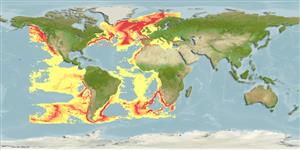Common names from other countries
Classification / Names / Names
ماع يماسا | فدارتم | Catalog of Fishes (gen., sp.) | ITIS | CoL | WoRMS
Environment: milieu / climate zone / depth range / distribution range
يسانش موب
گنس بآ هب هتسباو; قمع تارييغت 27 - 4312 m (Ref. 105406). Subtropical; 75°N - 58°S, 145°W - 36°E
Eastern Pacific, Atlantic Ocean, Mediterranean Sea to the Arctic: Western to northern Europe, and Western Africa.
Length at first maturity / Size / Weight / نس
Maturity: Lm ? range ? - ? cm Max length : 2.0 cm SHH يسنج صاوخ نودب / رن سنج; (Ref. 90120)
Inhabits deep-water coral reef mound (Ref. 105183). It is also found in sublittoral to abyssal depths, usually attached to rocks, stones, gorgonians, or hydroids on muddy and sandy substrates (Ref. 90120). Epibionts on the trunk of the black coral Leiopathes glaberrima bush (Ref. 105183). Colonized by the parasitic foraminifer Hyrrokkin sarcophaga (Ref. 105186). Suspension feeder (Ref. 105183). In general, suspension feeding bivalves mainly depend on phytoplankton and detritus material for nutrition (Ref. 107088).
Life cycle and mating behavior
غولب | لثم دیلوت | یزیر مخت | اه مخت | Fecundity | )ورال ( دازوت
Members of the class Bivalvia are mostly gonochoric, some are protandric hermaphrodites. Life cycle: Embryos develop into free-swimming trocophore larvae, succeeded by the bivalve veliger, resembling a miniature clam.
یلصا ذخآم
عجارم | هدننك گنهامه | ناراكمه
Demir, M. 2003. (Ref. 2754)
NCUI زمرق تسرهف رد تيعضو (Ref. 130435)
ستياس رظن زا تيعضو (Ref. 108899)
Not Evaluated
Not Evaluated
یناسنا هدافتسا
| FishSource |
اهرازبا
رتشيب تاعالطا
Age/Size
دشر
نزو - لوط
لوط - لوط
يسانش تخير
)ورال ( دازوت
يناوارف
يتنرتنيا عبانم
Estimates based on models
Preferred temperature
(Ref.
115969): 2.6 - 8.7, mean 4 (based on 528 cells).
